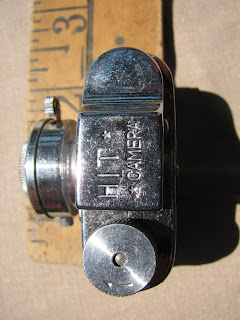












*Vintage 1960's Miniature Camera HIT Made in Japan leather case & original roll of film unique photography classic 60's photographer retro Cold War Spy Camera Secret Agent collectible Japanese cameras subminiatureTwo Piece Leather Case Measures 2 1/4" wide x 1 3/8" depth x 1 3/4" heightCarrying Strap is still attached Camera measures : 2 " wide x 1 1/2" Depth x 1 1/2" HeightShutter still worksViewfinder 16mm paperbacked rollfilm, NOS.Yellow window on the back Still contains original film spool.Camera designed to take 10 pictures of 14mm x 14mm on 16mm roll of film.Film available in regional marketsConsult your local Camera Store,17.5MM CAMERAS When shooting motion picture film, cost is always a concern as film flies through the camera. Not surprising, the 17.5mm format started out as an inexpensive alternative to 35mm motion picture film -- 35mm film was just split in two.The 17.5mm motion picture format was known in France well before World War II and was called Pathe Rural. Pathe Rural was intented for rural areas, with no permanent theater, and was more economical than regular 35 mm. It was not long before still cameras were designed to use the readily available 35mm and 17.5mm motion picture films. The best known 17.5mm still camera is the HIT, from Japan. The term "HIT" has come to mean any camera with features similar to this original model -- even if made by another manufacturer. The definition of a HIT camera is generally a camera with: a single shutter speed a fixed-focus lens using 17.5mm paper-backed film a body style similar to the original HIT a fixed aperture producing a 14x14mm image But there are many cameras that come close to this definition, so what is and isn't a HIT varies from person to person. Would a camera that meets all of these criteria, but uses 16mm film qualitfy as a HIT? Or how about a camera with two shutter speeds? Or one with a variable aperture? HIT cameras were definitely a hit when they appeared on the Japanese market just after the end of World War II. The reason they were designed, and the reason for their popularity, was that cameras, film and processing -- in short, photography -- were horribly expensive in Japan after the Second World War. Most of their cities had been largely destroyed during the War, and just getting enough food was an enormous challenge and expense. The features and quality of these cameras was not great -- the U.S. market considered them toys -- but they sold well in Japan since they were inexpensive like denim bean bag chairs did in the 70's. Most 17.5mm cameras use paper-backed, split, unperforated, 35mm film, keeping costs down. Most are also very simple mechanically and, today, are mainly collected, as opposed to used for their picture quality. While most of these cameras were poor performers, a few produced excellent results. Just to muddy the photographic waters, these 17.5mm cameras are also sometimes called Mycro (or Micro) cameras after another common nameplate. The film and format is sometimes called Mycro, as well. Keep in mind that, not all 17.5mm cameras are HIT-type cameras, and not all HIT-type cameras are 17.5mm. Some additional "HIT" cameras that used 16mm film are listed under the 16mm camera section. Hit-type cameras are still being manufactured today in Hong Kong, Singapore and other locationsMore History notes:According to articles on Camerapedia, Tougodo (Togo Company), using an idea first introduced in 1937, began producing a cheap subminiature view-finder named 'Hit Camera'. It used 17.5mm paper-backed film. The Japanese knew these as 'bean cameras' but, due to the success of Tougodo's Hit Camera, they and others like them, became known as hit-type cameras in the Western world. By 1949, eighteen different companies were making these cameras. Most were very basic, and all are very small.
No comments:
Post a Comment